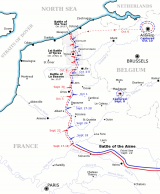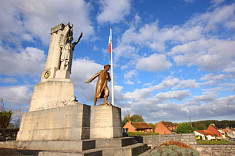Contents
The expression "race to the sea" was in fact coined some time after the events it describes took place. It refers to the confused struggle between the German and Franco-British Armies in the months of September and October 1914 on the plains of Northern France after the defeat of the German Army on the river Marne and its subsequent withdrawal to the river Aisne. Each side attempted to attack the rear of the other's northern wing in order to envelop it and this resulted in a series of movements which took the belligerents north towards the Belgian frontier and the shores of the North Sea. The race came to a halt in October when the war of movement became one of position. During the two months it lasted, the Germans almost always had the initiative, forcing the Allies to fill the breaches which threatened the Channel Ports and their vital communications with Great Britain.
Many of the events of this unexpected war of movement, itself punctuated with innovative tactics which heralded the coming trench warfare, took place around the city of Arras in the region of Artois. Much of the fighting saw exhausted and poorly-equipped French soldiers confronted with elite German troops but, despite the considerable losses, the Allied lines held and Arras never fell into enemy hands.
At Bapaume between 28 September and 11 October it fell to territorial units, sometimes supported by cavalry, to confront the German advance from Picardy which was directly threatening Arras. The main body of the French comprised the soldiers of the 14th Territorial Infantry Regiment and they attempted to hold the defence line north-west of Bapaume with nothing but rifles and a meagre reserve of munitions.
On 27 September the cavalry corps under the command of General Louis Conneau were sent to the west of Bapaume to fill a breach after several territorial units dislocated under pressure from German infantry. More indecisive confrontations took place at Irles and Courcelles-le-Comte where French dragoons were brought in to shore up the Territorials. Once the Germans were contained on the line stretching from Bapaume to Arras, the cavalry units headed north to take part in the operations to block attacks on Arras and Lens and outflank the German right wing. French reinforcements flooded in between 29 September and 2 October, transported by bus from the railway stations around Amiens. On 2 October the French were buffeted by a powerful assault at Monchy-le-Preux, to the north of Arras, but endeavoured to contain the German forces as they advanced on Lens. Meanwhile, fighting was raging to the west of Bapaume between the Prussian Guard and French units made up of Territorials, cavalry and the 37th Infantry Regiment. Savage mêlées were fought in several villages, the belligerents erecting makeshift fortifications as best they could. The Germans took Gommecourt on 5 October but failed the next day in their attempt to gain possession of Hébuterne where they suffered 350 soldiers killed and 297 taken prisoner. However try as they might over the next couple of days, the soldiers of the French 69th Infantry Regiment were unable to retake Gommecourt which the Prussian Guard had heavily fortified with deep trenches, barbed wire entanglements, machine-gun nests and field artillery. On 10 October the Germans took Monchy-au-Bois, Hannescamps and part of Foncquevillers. The following day began a bloody mêlée which saw the French retake control of Foncquevillers from the Prussian Guard and a Bavarian regiment. The occupiers had to be flushed out, house by house, using in some instances flat trajectory fire from 75 mm field guns.
Fighting between Arras and Bapaume died down after 14 October. The Germans entrenched themselves along a line which ran north to south and set up defensive positions on high ground and in the ruins of villages: the trench warfare of World War I had begun.
Yves Le Maner
Director of La Coupole
History and Remembrance Centre of Northern France
Archive pictures

Gsl / Wikimedia Commons (png - 0.07 MB)




